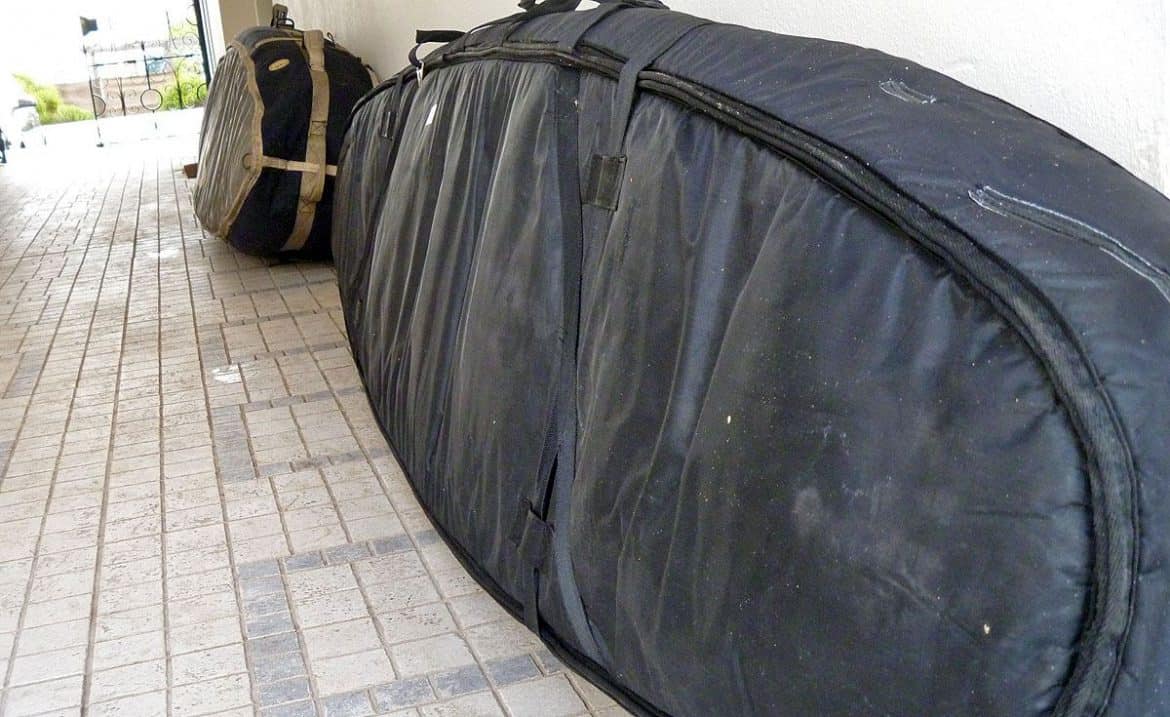Surfboards are fragile things intended for “soft” water and not for travel and airline abuse. Especially airlines can put a dent in your wallet and your zen state at the same time. They charge you extra for the surfboard, they make you sign that they can do whatever the hell they want with it and of course they keep their promise and you get a dinged board at the baggage pickup and no chance of compensation. Great. I’ve just payed 100$ so they can smash my board. All you can do is to fly with airlines that do not charge for surfboards and protect your board when you travel and to get the best damn possible surfboard bag. This is where this surfboard bag buyers guide and surfboard packing instructions come in. So what is the best way to pack your surfboard?
Table of Contents
Board Bag Guide
First you will need a surfboard bag. There are many different bags available today, these are the main types:
Sock or Stretch Cover

This is not really a bag and it only offers little travel protection, it’s main purpose is to protect your board from wax, scratches, dust and UV light. A surfboard sock is made from woven almost towel like elastic material that is maybe 2mm thick.
Features: tip protection, wax pocket, closing cord.
Where to use it? For jump down to the beach, for daytrips when board is inside your car, for short trips in motorcycle racks, for storing surfboards, for stacking surfboards one on top of another into bigger surfboard bag etc…
Single Surfboard Bag – Thin
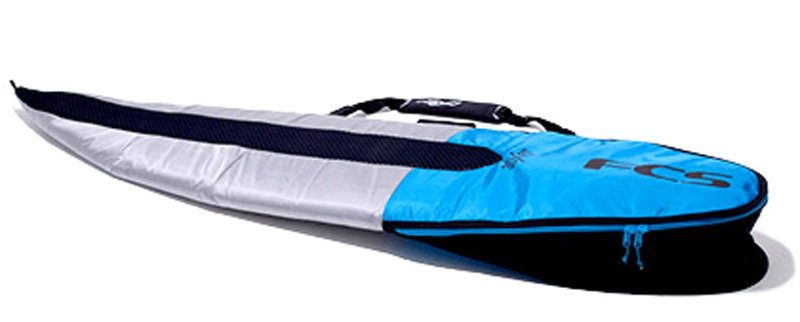
A thin board bag is a board bag that has 5mm or less protection. It has everything that a full blown travel bag has except the protective layer is thinner. This is the normal everyday board bag. You can use it whenever you are the boss of your surfboard from the moment you leave the house to the moment you hit the water. Why choose thin over thick? Well, it’s lighter and cheaper. Big thick board bags are clumsy and take up more space.
Features: The protection of the board bag lies in the protective high-density closed cell (doesn’t get wet) foam padding that is sewn into the bag. Obviously the thicker the foam the better the protection. Apart from that check if the bag has enough room in the tail to take a surfboard with mounted fins (most bags have extendable tail part). It should also have a reflective and waterproof outside so it doesn’t get wet and you board doesn’t get too hot inside. Some extra pockets for the fins and wax. Adjustable and comfortable carrying straps. A good zipper that won’t soon be corroded by the salt water dripping from your wet surfboard.
Where to use it? Daytrips to the beach by foot, bike, car, skateboard, motorcycle under your arm, on racks, in the trunk, on the roof etc… If this was my only bag I would even use it for longer trips when packing is under my control (no airline, trains…and other places where you have to give your bags to someone else) or if the bag is really big and can handle lost of extra protection around the board. More on that in packing tips…
Single Surfboard Bag – Thick
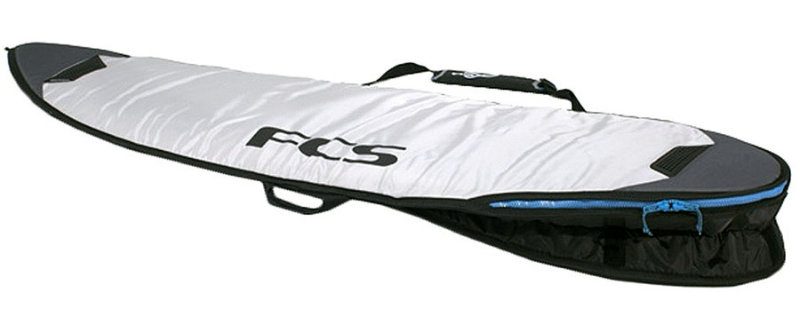
A thick board bag will have 10mm of protective foam all around the bag. Everything else is the same as with the thin version so I won’t repeat it.
Where to use it? Anywhere you want.
Two Surfboards Board Bag
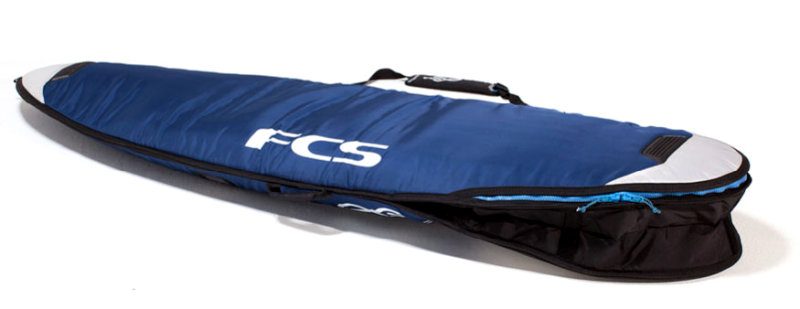
Almost all bags that carry more than one board have thick protection and are meant for travel. But they come in different shapes and sizes.
This one here is my favorite for shorter trips. It packs two surfboards without fins, it has a thin padded internal sheet to put between boards, it has internal straps and it still looks like a single board bag. You can also use it for daytrips on your surf trip or maybe even fool airline workers that you are only carrying one surfboard with you.
Where to use it? Anywhere you want.
Then there is another type bag for two surfboards and it looks like this:
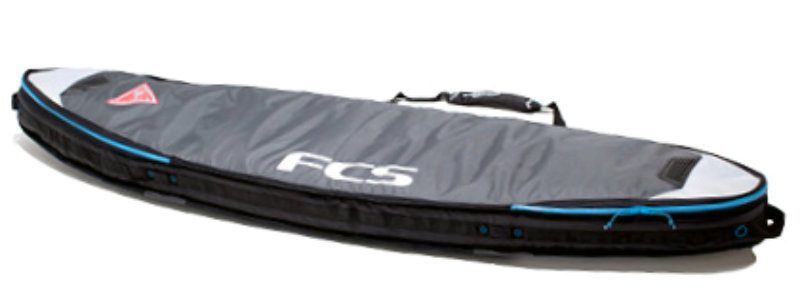
The main benefit of this second bag is that it fits two boards together with fins and that you can use it to pack some other things inside as well. Surfboards, boardshorts, towels etc… This is really handy for longer trips. And it comes really hand when you have to pay for your luggage. If you are paying for surfboards anyway, then at lest pack the surfboard bag with enough things that your only other piece of luggage is a small carry on backpack. This one is IMHO a must have in this surfboard bag buyers guide for every surfer that does trips (are there surfers that don’t go on surf trips?).
Features: Closed cell foam padding. It should also have a durable, heat-reflective reflective, and waterproof outside material so it doesn’t get wet and you boards don’t get to hot inside. Some extra pockets for the fins and wax. Adjustable and comfortable carrying straps. A good zipper that won’t soon be corroded by the salt water dripping from your wet surfboard. Internal sheets for separating your boards (you don’t want wax on the bottom of your board). Internal straps that fix the boards together and stop them from moving around the bag.
Where to use it? This is a travel board bag. So it’s very clumsy for a quick run to the beach, for daytrips etc… One week or more surf trips.
Multiple Surfboards Bags
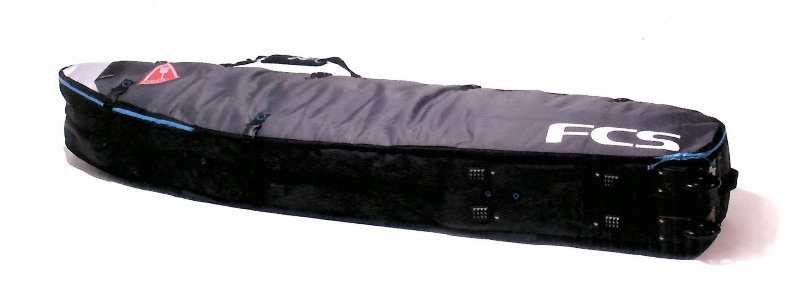
Bigger bags can take from 2-7 surfboards. Bags that take 2 or 3 surfboards can still be normal bags, ones that take more than 3 almost always have wheels in the back because they get to heavy to carry around. A bag this big is meant for pros that have lots of boards on their trips or for groups of surfers going together on a trip and want to share the airline surfboard fees.
Features: Same as two surfboard bag but with some extra possible feature like: wheels, soft roof racks and/or tie down straps, a thin single board bag inside (for daytrips).
Where to use it? This is a travel board bag. So it’s very very very clumsy for a quick run to the beach, for daytrips etc… The bag itself weights a ton and is not very carry-around-friendly. Pack at least a sock cover for going to the beach. Even with wheels, it can be difficult to carry around of you hit dirt. So airport to taxi on tarmac – awesome. Small boat on sandy beach to small hut on the other side of the road less island – not so good.
How to choose the right board bag size?
Now when we got the types covered lets look at the sizes. For a perfect fit the bag has to be just the right size. Board must slide in easily but not float around the bag. A bag that is so tight that you hardly get the board inside is too small.
Usually board bag manufacturers design the bags in such way that if you buy the bag that is the same size as your surfboard it will be just the right size.
If you have a 6’7″ board get a 6’7″ board bag. Bag will have all the extra space that you need, there is no need to buy a bag that is a few inches longer. Of course – if your surfboard is between available bag sizes get the next bigger bag.
Then there is the shape of the bag. There used to be only shortboard and longboard bag models, but today you will find:
- shortboard bag
- funboard bag
- fish bag
- hybrid bag
- longboard bag
Why? Fish/funboard/hybrid boards are too wide for a regular shortboard bag, and then there is the shape of the nose – a wide nose again won’t fit into the pointy shortboard bag. So make sure you get the right model. Most bag manufacturers give the max dimensions of the board that will comfortably fit into the bag .
How to pack your surfboard for travel?
There are two schools of surfboard packing :)
- the ‘don’t put anything but the board’ into the bag school, and
- the ‘add as much protection as possible” school.
The idea behind the first one is that extra stuff like towels, wetsuits, booties etc…can actually turn into a lever against which the board is damaged. You don’t want stuff floating around your board bag, making a big lump under or between the boards…not good! So if you place extra things in your bag for protection or because you’ve ran out of space in your normal luggage make sure these things are fixed inside the board bag. If towels and wetsuits do add extra protection for your board but things like fins and other hard/sharp objects should stay out of the board bag.
I personally think that no matter the protection a huge plastic sharp-edged suitcase thrown onto your board bag will always make damage :(. So most of the time I don’t even bother with extra protection. Just my boards and a thick board bag and most of the times I’m okay.
But if you want to be extra safe, this is the ultimate bulletproof step by step packing system:)
1. Fins
Fins sticking out of your surfboard are an accident waiting to happen so first you need to remove the fins. If you have glass-on fins then the best solution is to stick a piece of polystyrene on them and make holes for the fins. You can even buy a special pre-shaped piece of foam called a fin-box for this purpose. You can get it in some surf shops. BTW – don’t forget to pack the fins once you remove them:)!
2. Rail protection

For protecting your rails either buy an insulation foam tube or foam protection that carpenters use for protecting furniture edges during transport. The later can be put on the rails right away, some even have small sticky glue bubbles on the inside so they stick to the rail. If you use a foam tube buy one that is a few inches longer than your board. Then cut it in half lengthwise but leave the top joined. Stick your board into the split tube so the joined part sits on the nose and the cut tube runs down the rails.
Either way – use duct tape to secure your rail protection to your board or it will fall off.
3. Bubble Wrap
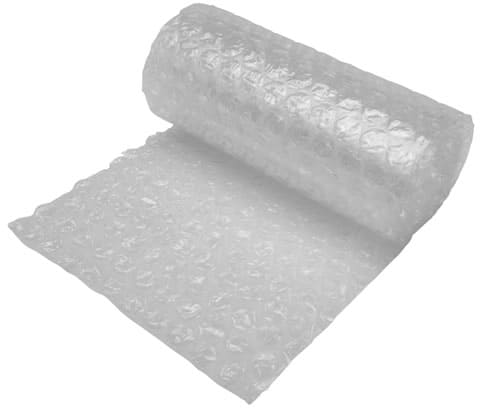
Wrap your board in bubble wrap – get one with big bubbles if possible and duct tape it so its fixed. If you travel a lot just get a huge roll and store it in the garage.
4. Board Bag
Put the board into the bag. If you are packing a single surfboard IMHO don’t stick in any additional protection like towels and wetsuits. A regular and fitting board bag should be just big enough to fit the protected surfboard. Anything else is pushing it.
But if you are packing more boards, here are a few extra tips.
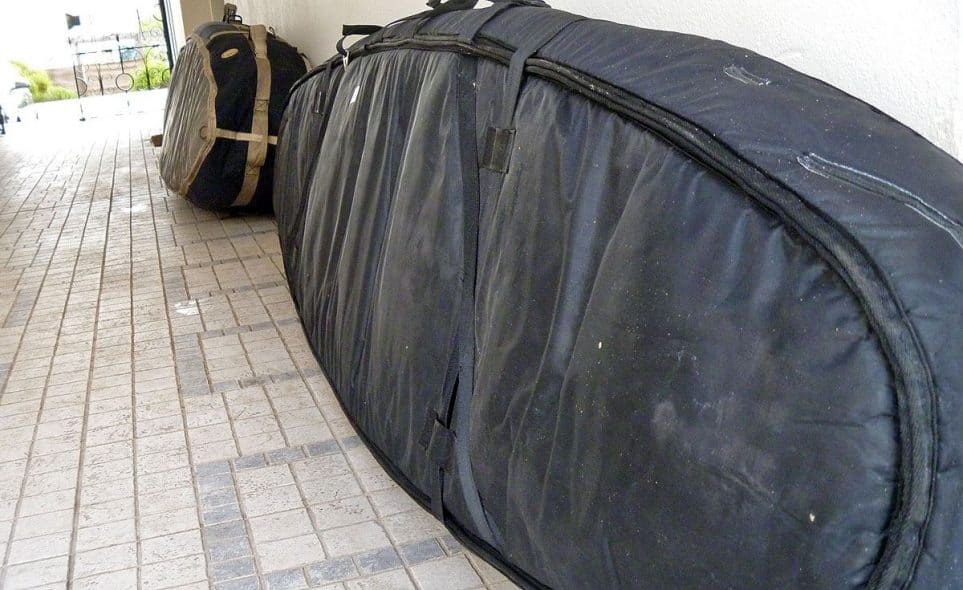
5. Multiple Surfboards Packing Tips
- Prepare the boards like in steps 1 and 2.
- For step 3 it depends how big is your board bag. If you can bubble wrap each board separately – do it! If not then put towels (or one layer of bubble wrap) between them and then wrap them all together.
- Always stack the boards so that the longest is at the bottom and the shortest is at the top (wax side up!). Keep noses and tails together so that the rocker of the boards flows in unison.
- If there is a big gap between boards noses duct tape some clothing in between but be careful not to overdo it!
- Strap boards inside the bag so they stay together. Most board bags have internal straps for that.
- In bigger board bags you will still have empty space around your boards. Use straps to adjust the size of the bag if this is an option or fill this space with wetsuits, towels, t-shirts, boardshorts etc… and try to fix them so they don’t slide around the bag. Don’t put hard/sharp objects into the board bag!
PS: Put your name, address, phone and email somewhere on the bag and write FRAGILE on it. Good luck!
If you have some extra packing tips, let me know in the comments.

